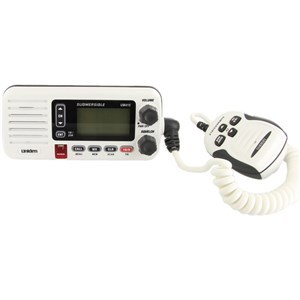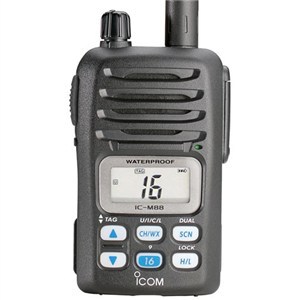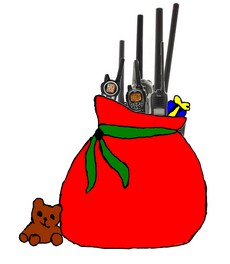One of the most important things to have with you when you are out on the water (besides something to keep you afloat) is a means of two way communication, such as a radio. If you are a boater, you probably already know how important it is to have a radio on board.
Marine VHF radios are commonly used on seafaring vessels both large and small to communicate ship-to-ship or ship-to-shore for everything from routine contact with ports and marinas to emergency distress calls. These radios operate using VHF frequencies from 156 to 174 MHz.
Marine radios operate very much like your typical land-based two way radio, but with some differences in channels, wattage, range and features. VHF marine channels are different than those used for land based radios and are specifically for use in marine environments. They are allowed to operate between 1 and 25 watts. Because transmissions primarily occur over open water, their range will generally be much greater than land-based radios.
Marine radios also offer many additional features not found on most land-based radios, such as emergency weather alerts and weather-proofing. It is not uncommon for marine radios, particularly handheld units, to be submersible in water and even float.
One important feature often found in a VHF marine radio is Digital Selective Calling, or DSC. DSC is part of the Global Maritime Distress Safety System (GMDSS). A Class-D (DSC) Digital Selective Calling-capable VHF radio has a second receiver to monitor Channel 70 (DSC channel) activity at all times while receiving another channel. DSC allows the user to send a distress signal at the push of a button without using a microphone to exchange position information with other boats or stations. As of March 25, 2011 marine radios are now required by the FCC to be Class-D DSC complaint.
The FCC has set specific requirements for users of marine radios operating within US jurisdiction. The FCC states: Depending on the size, purpose, or destination of a ship, its radio station must meet certain requirements established by law or treaty.
On October 25, 1996, the FCC released a Report and Order in WT Docket No. 96-82, 11 FCC Rcd 14849, FCC 96-421 (pdf), eliminating the individual licensing requirement for voluntary ships operating domestically which are not required by law to carry a radio. Voluntary ships are those that are not required to have a radio. WIth a few exceptions, most recreational vessels are considered voluntary.
According to the FCC, domestic vessels are those that do not travel to foreign ports. If your vessel travels to ports in other countries, you will need to have a license. The FCC rules require certain vessels to be equipped with radio equipment for safety purposes. These rules are set in accordance with international agreements.
Marine radios typically have 88 channels, however not all of those channels are allowed to be used by everyone. Certain channels are reserved for specific types of communications or for specific groups, such as commercial ships and the Coast Guard. For instance, Simplex channels, 3, 21, 23, 61, 64, 81, 82 and 83 CANNOT be legally used in U.S. waters by the general public. Channel 16 and Channel 9 are emergency channels and are reserved specifically for emergency communications. Channel 16 (for voice) and channel 70 (for digital DSC) being monitored 24 hours a day by the US Coast Guard.
In addition to the other requirements, there is one other very important rule to note: Marine radios are specifically intended for marine use. It is illegal to operate a marine radio on land.
There are two basic types of VHS Marine Radios, fixed mount and handheld. Fixed mount radios are installed or mounted in your vessel. Handheld radios are carried with you like any other handheld two way radio or walkie-talkie.
Examples of fixed mount VHF marine radios are the Icom IC-M412 (available in black or white) and the Cobra Marine MR-F80B-D Class-D Fixed Mount Submersible VHF Radio. Examples of handheld marine radios are the Midland Nautico 3VP, and the Icom IC-M36 VHF Marine Radio. Cobra, Icom, Midland and Uniden are all popular brands of marine radios.
When shopping for a marine radio, it is important to note that while antennas are typically included with handheld radios, an antenna is not included with fixed mount marine radios and are purchased separately. This is because the antenna will be mounted somewhere externally on the vessel itself. Marine radio antennas vary in size, length and type and your choice of an antenna may vary depending on where and how it will be mounted on your vessel.
For more information about the basics of choosing and using a marine radio, listen to The Two Way Radio Show Episode 16 - An Introduction to Marine Radios.
 If you own or operate a fishing or small passenger marine vessel, the FCC wants to remind you to upgrade your craft with VHF radiotelephone equipment with Digital Select Calling (DSC) capability by January 20, 2016.
If you own or operate a fishing or small passenger marine vessel, the FCC wants to remind you to upgrade your craft with VHF radiotelephone equipment with Digital Select Calling (DSC) capability by January 20, 2016.









